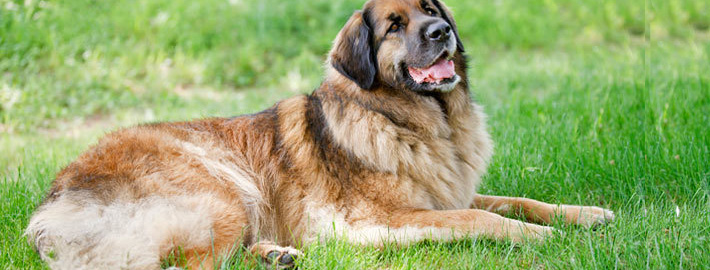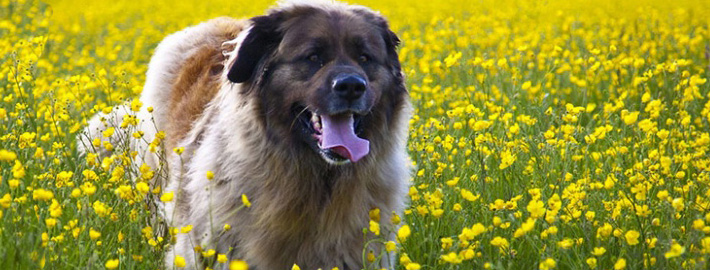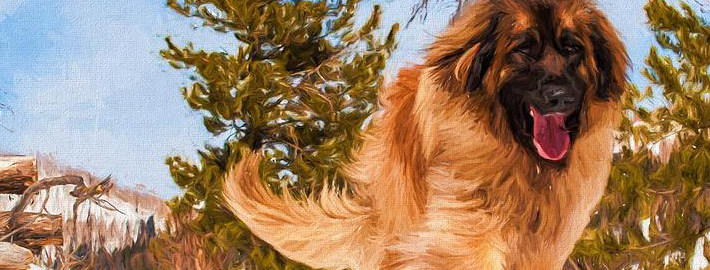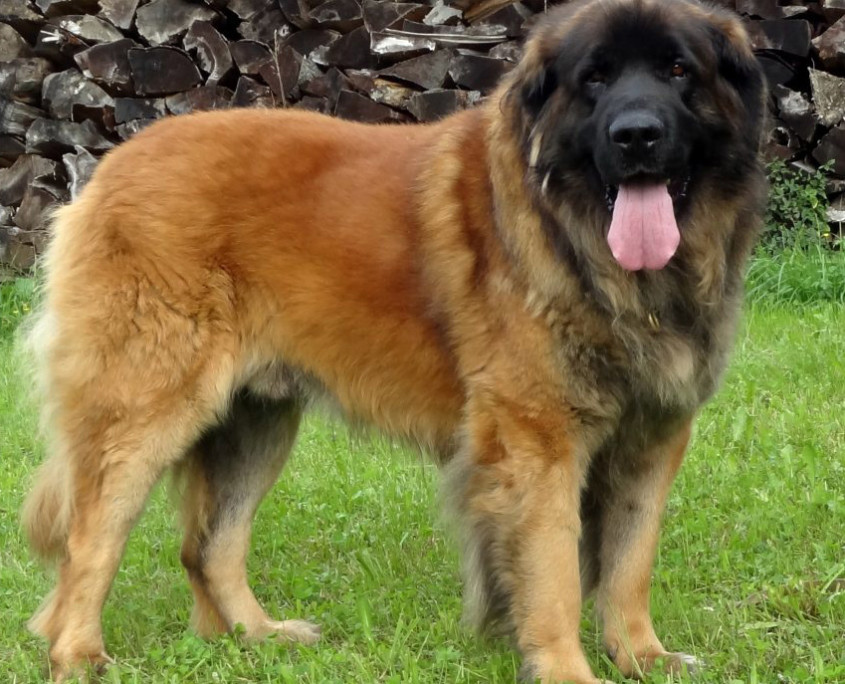What makes the Leonberger Unique?
Leonbergers, or Leos, as they are known to their friends, are loyal, outgoing “lions” who love children, other animals, and water. Originating in the mid-nineteenth century in Leonberg, Germany, these wonderful, weatherproof family dogs are arguably the oldest of the German pure breeds. Although fairly well-known in France, Germany, and Scandinavia, they are still considered a rare breed in most countries.
One of the giant breeds, the Leonberger is powerful and elegant. Females stand 26 to 28 inches at the withers and weigh more than 100 pounds. Males are usually considerably larger, standing 28-31 inches and weighing as much as 150 pounds (although most are in the 120-pound range). Their luxurious double coat is lion-colored, ranging from a light sand to a rich mahogany, accented by a black mask and often black tips on the body fur. Their noble, impressive appearance is complemented by dark, almond-shaped eyes characterized by an open, gentle, friendly expression.
Breed Groups
Page Contents
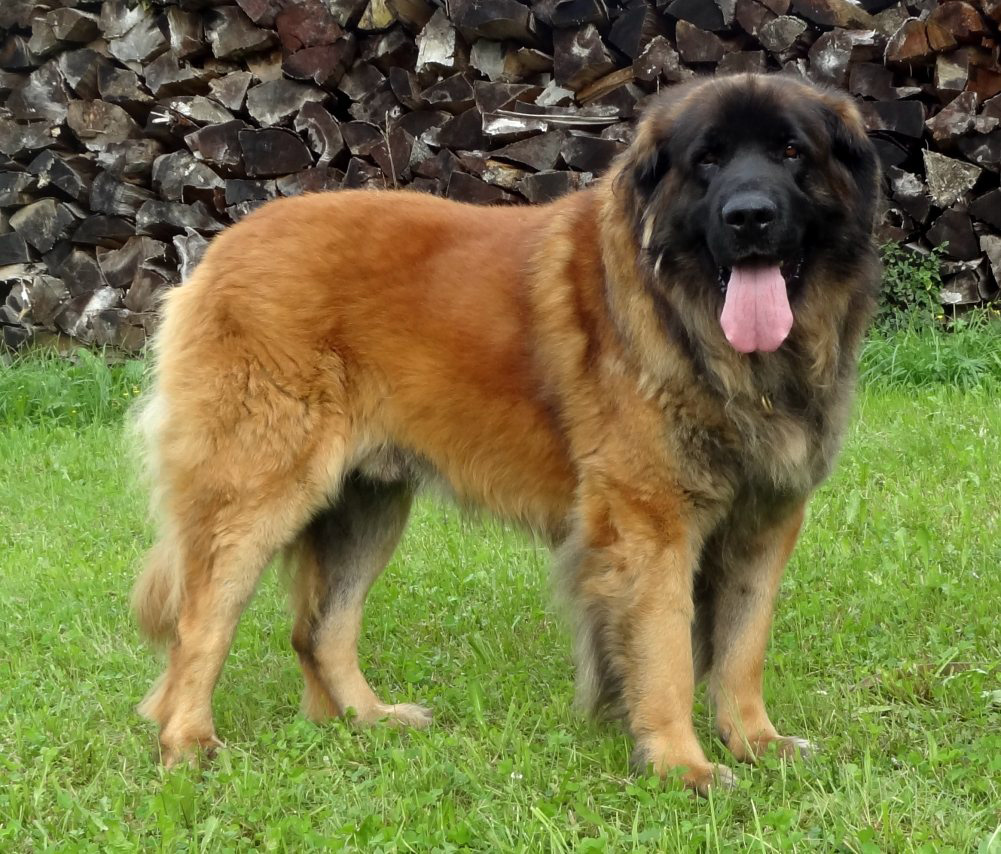
SnapShot
| Size: | Males 29 – 31 inches (74 – 80 cm)
Females 27 – 29 inches (61 – 74 cm) |
| Weight: | Males – 130 – 170 pounds (59 – 77 kg) Females –100 – 130 pounds (45 – 59 kg) |
| Origin: | Germany |
| Life Span: | 8-9 years. |
| Colour: | Black mask with a light yellowish golden color to a red-brown colored coat. Lion colored |
| Litter Size: | 6 – 14 puppies |
Is the Leonberger Right For You?
Most Leonbergers are wonderful, loving dogs, but due to their size and strength, they are NOT the dog for everyone. They require time, dedication, grooming and, above all, training to ensure a well-behaved dog. Buying any dog should be a lifetime commitment, so make sure you learn about the Leonberger before you buy. As with any breed of dog, do not buy a Leonberger if you somehow believe it will be a catalyst toward changing your life style. It won’t. Research and purchase a dog that matches your lifestyle as it currently exists.
In 5 Words
- Lovable
- Calm
- Gentle giant
- Sociable
- Agile
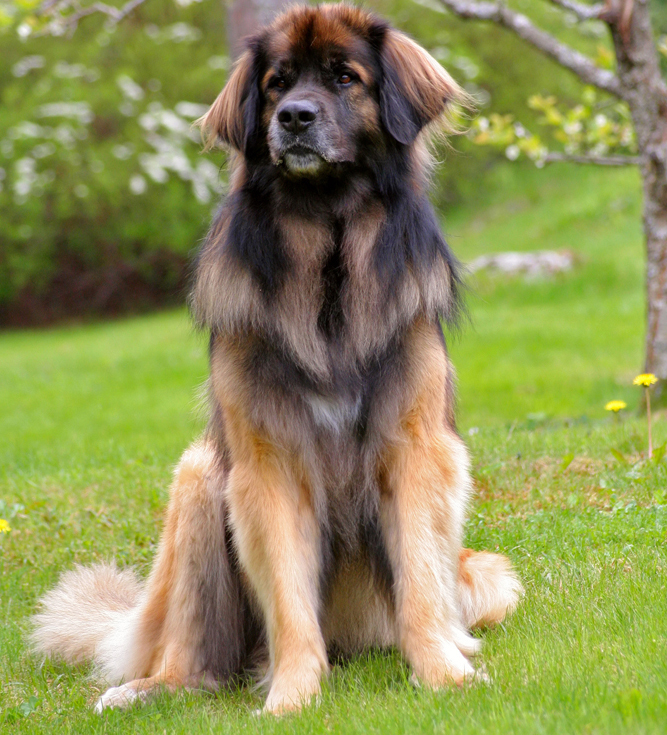
Characteristics
Learn About the Leonberger
Description
General Description
This is a very large, muscular working dog. The head is rectangular shaped and deeper than it is broad. Males’ heads are generally larger than females’ heads. The skull is somewhat domed. It has a black mask and a rather long muzzle. The black mask should not extend above the eyebrows; the mask can be up to the eyes or above the eyes, but never over the entire head. The large nose is always black with clearly outlined nostrils. The lips should be black, and are usually tight and dry. In males with a very majestic head, slightly loose flews and sometimes slightly open hooks of eyes are often found. Loose flews collect saliva, so some males might drool slightly. The teeth should meet in a scissors or level bite. The medium-sized ears are triangular in shape, fleshy, hanging flat and close to the head. The tips of the ears are level with corners of the mouth. The neck is muscular and strong with no dewlap. The medium to long, water-resistant, double coat comes in lion-yellow, golden to red, red-brown, sand, cream, pale yellow and any combination of those colors, always with a black mask. All colors may have shorter, medium or long black tips on the outer coat. There may be a small stripe or white patch on the chest and some white hairs on the toes. There is always discussion about the amount of white allowed. FCI standard states “like the palm of a hand,” but it all depends on whose hand you are referring to. The Leonberger’s thick mane creates a lion-like look. The mane in males can take up to 4 years to develop; the mane in a female is less obvious than in a male. Rear dewclaws are sometimes removed. The front and rear legs are feathered. The bushy tail hangs straight down. The pads of the feet are black. They often have webbed feet.
Short History of the Leonberger
The Leonberger is the symbol of pride to the town of Leonberg in southern Germany. In the 1840s Herr Alderman Heinrich Essig, the Mayor of Leonberg, wanted to create a breed that manifested the same appearance as the lion which appeared on the Imperial Coat of Arms in the Town Hall of Leonberg. He set out to do so by crossing the Newfoundland, Landseer, St. Bernard and Pyrenean Mountain Dog. The breed has been bred since 1846. Some believe that the breed descends from the Tibetan Mastiff. When first exhibited, the Leonberger was not accepted by the judges as a breed, simply as a mixture of other dogs, which is what it was. But Essig did succeed in creating a rather handsome breed, which went on to be accepted by the public and involved in the World Wars. Unfortunately, existing in a warring country, starvation and the enemies of Germany was what almost made them extinct. After World War I the breed had only 5 remaining survivors. After careful nurturing and help from breeders, the Leonberger was on its way to recovery. After the second World War the breed was nearly decimated again. Only eight remained this time, and it took about 25 years for the breed to be stable in numbers again. It is still considered a rare breed today, but its numbers are up. In 1949 the breed was given a standard to judge by, and clear distinctions were made between the Leonberger and Saint Bernard.
Temperament
The Leonberger has a lively nature. It is brave, intelligent, steady and affectionate. It has a sweet expression. Loving and steadfast, stable and calm, the Leonberger just loves everyone. Its intelligence is extraordinary; its loyalty and love for its family is unparalleled. He has a friendly personality. A well-balanced Leonberger will be highly trustworthy and have incredible patience, even with the most obnoxious children. With most of these dogs, if the situation becomes too intense, instead of showing any aggression, the Leonberger simply walks away. Most of these dogs can take bad behavior in their stride. The Leonberger does not respond very well to harsh training methods; training requires patience. Owners need to be firm, but calm, confident and consistent. Proper human to canine communication is essential. To be an excellent watchdog requires some special training. Often called a gentle giant, the Leonberger is serious, eager and willing to please, responding well to training. The Leonberger can get along with other dogs. Socialize and train early, as this puppy will become a very large adult. Teach your dog to respect humans by training it not to jump, to heel on the lead and to enter and exit all door and gateways after the humans. The Leonberger is more active and coordinated than many other giant breeds.
Caring for Your Leonberger
General Health
Unfortunately the Leonberger suffers from various health issues, including Addison’s disease, hypothyroidism, cancer, ectropion, entropion (inverted eyelids), hip dysplasia, osteosarcoma, OCD and bloat. Bloat is a health issue common to most dogs, being the second largest killer of all dogs. But Leonbergers can be particularly susceptible to it because of their deep chests. Bloat is also known as twisted stomach or gastric torsion.
Grooming & Bathing
Weekly brushing is needed. The ears must be kept clean and the teeth cleaned when needed. Bathe only when necessary. Some de-matting is required to avoid hotspots. Wetness and damp/wet weather conditions are responsible for the hot spots. Check behind ears, feathering on legs and tail for mats. The Leonberger is a seasonally heavy shedder; during this time the dog should be brushed and combed daily.
Exercise & Training
This breed does not need a lot of exercise, however, it does need to be taken on a daily walk. While out on the walk the dog must be made to heel beside or behind the person holding the lead, as in a dog’s mind the leader leads the way, and that leader needs to be the human. They love to be included in all family outings and are very adaptable to most any environment. They LOVE to swim, hike and be trained to pull carts and sleds. If you plan to have your Leo pull carts or hike, one has to wait until the dog is grown. It is not recommended before the dog is about 18 months old.

